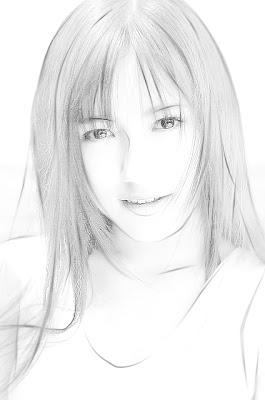Pencil Sketch Tutorial Biography
Source(google.com.pk)As you can see, I'm using 0.7 mm lead. I will also use a 4H, HB (#2) pencil and a Kneaded eraser (also known as putty rubber) for picking up graphite particles. These tools will give you precise control over what you draw.
Photorealism evolved from Pop Art in the 1960's. It was a reaction against the ubiquitous use of photography in media and abstract expressionism in art. I happen to enjoy both realistic and abstract art and don't see a reason to compare. Everything is cool on some level, I suppose. The one thing realism is particularly good at is reaching a broad audience with the clear message: nature is beautiful. In photography, even a tragic image can be breathtakingly beautiful. In photorealistic art, sometimes the same can be achieved, but with an extra human dimension. With this in mind, always strive for a little tension and conflict. You can save all the drama for your momma, but in art, go ahead, pour everything out --and in the end perhaps you'll capture something ineffable or at least your very best.
Okay, let's start:
The human face is probably the most difficult subject to render accurately. It takes years of practice to develop the skills needed to capture proportions and subtle features that make for a convincing resemblance of a person. If you're not a portrait artist, you can still use these techniques to draw other subject matter. A piece of machinery or tree trunk or still-life of any kind can be a beautiful and impressive work of art. If you feel that you have little artistic talent, you may want to try a simple exercise to shift your consciousness to the right side of your brain. Take a photograph and turn it upside down. Then try to draw it. You may be surprised at how well you draw. However, an artist doesn't necessarily have to be 'right brained.' You also don't need to be left-handed (I'm right handed).
Ideally, work from a very detailed, high resolution photograph with good contrast. If you have a graphics editing program, such as Adobe PhotoShop, crank up the levels until all the details are dark enough to see. Use your computer screen to zoom in on the details. Being able to see a close-up of a particular facial feature makes it much easier to draw something with photorealistic detail.
The first stage is the hardest part of the drawing. You are solving a difficult problem: how to create a two dimensional representation of a three dimensional object. This example is particularly difficult since it is a three-quarter view, and will depend on careful observation.
With an HB (#2) pencil, very lightly scribble the forms that create the illusion of volume. Draw, erase, redraw and erase again. The thick watercolor paper will serve you well as you erase many times. The key is permitting yourself to make a multitude of mistakes until you begin to see progress. If you look at an old drawing by a renaissance master, you may notice many stray lines, which reveals the great struggle that sometimes takes place as the drawing is developing.
Remember, this is not a classical drawing. You'll have to betray all your artistic notions about the creative method. Instead of organically building the composition up as a whole, photorealism requires that you work mechanically, This early stage of the drawing is the closest you'll come to a melodic artful approach. It may even look like a gesture drawing, loose scribbles, until something forms and emerges from the chaos. As you activate the plane with energy, use this time to express movement and emotion.
When designing user experiences with interactive surfaces, hand drawn paper-pencil sketches are a valuable tool for finding the right design; long before refining the work and getting the design right [1,2]. Sketches are lightweight and easy to create, and by varying the fidelity of sketches they can be an integral part during all stages of interaction design. This hands-on tutorial will demonstrate how to integrate sketching into researchers’ and interaction designers’ everyday practice – with a particular focus on the design of applications for interactive surfaces (e.g., phones, tablets, large interactive whiteboards). Participants will learn essential sketching strategies, apply these in practice during various hands-on exercises, and learn the various ways of using sketches as a powerful tool when designing novel interactive systems.
Pencil Sketch Tutorial Photos Wallpapers Images Pics Collections
Pencil Sketch Tutorial Photos Wallpapers Images Pics Collections
Pencil Sketch Tutorial Photos Wallpapers Images Pics Collections
Pencil Sketch Tutorial Photos Wallpapers Images Pics Collections
Pencil Sketch Tutorial Photos Wallpapers Images Pics Collections

Pencil Sketch Tutorial Photos Wallpapers Images Pics Collections
Pencil Sketch Tutorial Photos Wallpapers Images Pics Collections

Pencil Sketch Tutorial Photos Wallpapers Images Pics Collections
Pencil Sketch Tutorial Photos Wallpapers Images Pics Collections
Pencil Sketch Tutorial Photos Wallpapers Images Pics Collections

Pencil Sketch Tutorial Photos Wallpapers Images Pics Collections

Pencil Sketch Tutorial Photos Wallpapers Images Pics Collections


No comments:
Post a Comment